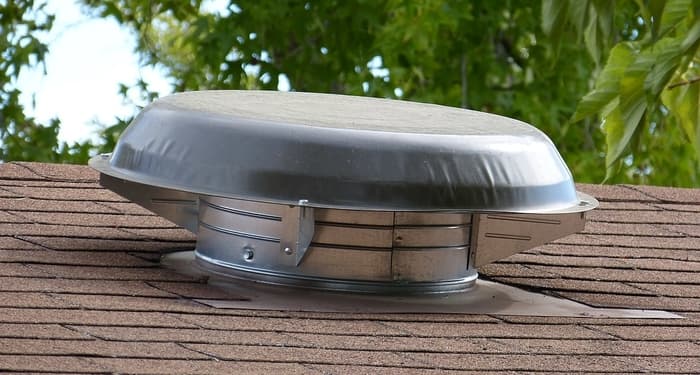Last Updated on March 12, 2023
Portable air conditioners are the most mobile and flexible kind of air conditioners. You can conveniently transport them from one room to another, or change locations and orientation with in a single room. But do the same convenience applies to its venting. Can you vent them into the attic?
You can vent a portable AC into the attic to expel hot air. However, this is not recommended, especially for relatively small and inadequately ventilated attics. Heating of attic results in warming of your entire home, rendering cooling operation inefficient and less effective. Also, many units expel humidity through vent that may cause mold and mildew in your attic.
The type of portable AC you are venting into attic will affect its efficiency and cooling operation. Generally dual hose portable AC are more efficient and perform better cooling. But with both vent hoses in the attic warm air will be sucked in the unit. This will result in low efficiency and inferior cooling.

There are various factors that have to be taken into consideration to truly know how practical cooling operation will be with this configuration. In certain cases, it may be OK to vent your portable AC into attic depending upon these factors.
In case you do have to vent your portable AC in the attic, there are certain measures that you can take to allow better cooling, better venting and more importantly protecting your attic from any damage. Just follow this article. I have tried to cover every aspect in this situation.
Warm Attic Can Cause Problems (Factor # 1)
Portable air conditioners are mobile and flexible cooling appliances. However, they do require venting, just like all the other types operating on vapor compression cycle. The purpose of venting is to expel heat out in the form of hot air.
If you are venting your portable AC in the attic, all this hot air will be expelled there. As a result, attic temperature will rise.
If your attic has enough ventilation, to expel this heat by air current, temperature of attic will be normalized constantly due to this. This phenomenon is called convection.
However, when ventilation is not adequate, attic temperature will constantly rise due to inadequate convection. This is the scenario that we don’t want, as it will add to the heat content of entire house.
As a result, temperature of the entire home will increase. More effort will be required by your portable AC to bring your room to desired temperature at the expense of higher electricity consumption. Thereby overall efficiency of cooling process is reduced.
If ventilation is poor and attic is relatively small then temperature will rise to detrimental levels. Even without venting temperature could rise up to 50 degrees above the required temperature.
With the addition of heat due to venting of your portable AC, temperature may go even beyond that. This could damage your construction like roof tiles.
Humidity Levels In Attic and Self-Evaporating AC (Factor # 2)
Many modern portable air conditioners, in fact most of them, are self-evaporative. This means that they capture humidity in the room in which you are running them, but they also expel it through vent hose.
There are two general types of portable AC that are self-evaporative: Partially evaporative and Fully evaporative.

In partially evaporative portable AC, water vapors are stored in condensate pan in liquid state. They are expelled from vent with hot air during AC operation.
While in fully evaporative portable AC, humidity extracted from the room is completely expelled with hot air from vent hose.
They are convenient options. By using them, you do not have to be that concerned with removal of water from condensate pan. You either have to remove it rarely or not at all.
However, if you happen to use of these kinds of portable ACs do not vent them to your attic. They will expel humidity to your attic and ruin it. High relative humidity in the attic boosts microbial growth, mold and mildew.
You are only safe to vent your portable AC into the attic if it doesn’t have self-evaporative technology or there is an option to stop the expulsion of humidity through vent hose.
The only scenario when partially or fully evaporative portable AC may be vented into the attic is when you have an adequate ventilation to consistently remove water vapors exhausted from vent of your portable AC.
Mold in attic is a serious health hazard. It causes respiratory illness, weakened immune system and allergic reactions. Also, in case you don’t use attic, mold can travel through tiniest openings in the walls down to your living space and kitchen.
Type of Portable AC: Single Hose Vs Dual Hose (Factor # 3)

There is another categorization of portable air conditioners. It is based on location from which air is sucked to cool the refrigerant in condenser coils.
There are two categories based on that: Single Hose Portable AC and Dual Hose Portable AC.
As the name suggests,
A portable AC with one vent hose is a single hose portable AC.
While a portable AC with two vent hoses is a dual hose portable AC.
When you are venting your portable AC into the attic, then to truly know whether it is feasible or not, you should know what kind of portable AC you use.
Let me tell you the difference of their operation in a simple way…
In single hose portable AC, air is sucked from within the room. That air then cools refrigerant in the condenser. It extracts heat energy and exhausts through vent hose.
In dual hose portable AC, air required to cool refrigerant is sucked from outdoors, instead of indoors, and exhausted outdoors. The only difference is from where air is taken to cool the refrigerant in condenser.
Generally dual hose portable AC is more efficient and effective compared to single hose portable AC. However, when you are venting to attic situation is different.
In case you have both hoses directed to the attic, hot and humid air from exhaust hose will be sucked by intake hose. So instead of intended increase in efficiency, with dual hose portable AC, it will considerably reduce.
In short, using a dual hose portable AC, when venting into attic, will get poor results, in terms of efficiency and cooling effectiveness, instead of better, compared to single hose portable AC.
Not to talk about humidity that is eliminated by exhaust and sucked back again, causing immense waste of energy and bad AC performance.
Length of Portable AC Hose To Attic? (Factor # 4)
Vent hose that comes with your portable AC is specifically designed for it. If you try to extend it beyond limit or change its dimensions, it will still work. However, you will compromise efficiency and effectiveness when you do that.
As I discussed earlier, when venting into attic, you must have adequate ventilation. So if high temperature and humidity is not a problem and there is proper airflow in your attic, only then think about venting into it.
The next obstacle you may face is the maximum recommended length of your portable AC’s vent hose, compared to distance between your room and attic. If the distance, from room to attic, is in the prescribed range of the hose then there is no problem.
Generally, the average length of vent hose is 5-7 feet and it is provided with your portable AC. However, maximum extendable lengths are different. Some are extendable only 3 feet. It really depends on the model and make of your portable AC.
If you extend portable AC vent hose beyond maximum length recommended by manufacturer, it would affect its operation. Consequently, performance of your unit will be compromised.
Portable ACs are mobile but not as effective as other cooling appliances. It is better to look for these factors to be able to achieve the max out of your portable AC, so that it is sufficient for your room.
Try not to use hose with length more than 12 feet as it would significantly deteriorate AC operation. Prevent 90-degree bends when extending it to your attic.
Temperature and Humidity Problems in Attic? Try These Solutions
Your attic must have adequate temperature in winters and summers.
In winter, if your attic becomes warm during the day, it would lead to ice damming. This means ice on top of the roof will melt and refreeze at gutters. This may damage it and result in interior leaking.
In summer, high temperature will cause entire home to heat up. Sufficiently high temperature may damage construction for example roof tiles. High humidity can cause mold and mildew that is detrimental. They can move through smallest openings and reach your living room and kitchen.
On top of that, if you exhaust humidity and hot air from your portable AC to your attic, the harm would increase several folds. But worry not, solutions given below will most probably resolve these problems and keep your attic healthy.
Solution 1: Natural Ventilation

This is the most common way to vent your attic. It is also called passive ventilation.
The basic principle employed in this type of ventilation is the fact that warm air is lighter and it moves to the top of the roof, while cold air is heavier so it is in the lowest part.
To maintain adequate temperature, airflow is created using intake and exhaust vents.
Intake vent is at the lowest part of the roof installed directly in the soffit or entire length of eave. Cooler air enters through intake vents.
Exhaust vents are close to the top of the roof to expel hot air. In this way cool air moves inside and hot air moves outside eliminating heat.
Solution 2: Powered Ventilation

This type of ventilation is carried out by the application of fans. They will allow forced airflow through the attic.
The stagnant air in the attic is replaced by fresh air using fan(s). There are several configurations though two basic types: Rooftop fans and Gable fans.
Simply put, rooftop fans are on top of the roof. They expel hot air inside the attic while replacing it with cool air. Gable Fans on the other hand are two in number and installed on opposite sides of the attic.
Note: When using powered ventilation, you should make sure that your attic intake vents are not blocking airflow. Otherwise, it will work to suck air conditioning from the house.


